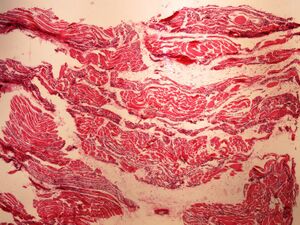Atrophy - pathology
|
This article was marked by its author as Under construction, but the last edit is older than 30 days. If you want to edit this page, please try to contact its author first (you fill find him in the history). Watch the discussion as well. If the author will not continue in work, remove the template Last update: Monday, 17 Apr 2023 at 1.32 pm. |
Atrophy means the shrinking of a normally developed organ , caused by the loss of cells or a decrease in their size. It can be a physiological or pathological process.
- atrophy affects the elements of the parenchyma , resulting in a relative increase in ligaments
- an atrophic organ is smaller and stiffer , its function is also reduced (after the cause is removed, the size and function of the tissue can be restored)
- hypoplasia must be distinguished from atrophy , which is the reduction of an organ due to its insufficient development
- complete failure of the organ to develop is referred to as aplasia or agenesis
Distribution of atrophies[edit | edit source]
- diffuse – does not lead to a change in the shape of the organ
- bearing – there is a change in the shape of the organ
- numeric – reducing the number of cells
- simple - reduction in cell size
Numerical atrophy[edit | edit source]
- the number of tissue or organ cells decreases (the opposite of hyperplasia)
- it most often affects tissues with rapid cell turnover
- an example is numerical bone marrow atrophy (marrow attenuation)
- it is a relative loss of hematopoietic marrow in favor of adipose tissue
- the result can be the suppression of all lines of hematopoiesis (aplastic anemia)
- inflammatory atrophy:
- if the breakdown of cells occurs rapidly during numerical atrophy, the breakdown products from dying cells cause inflammation with new tissue formation
- lipomatous atrophy:
- the loss of parenchyma cells during numerical atrophy can be masked by the increase of fat tissue in the interstitium (the organ is then normally large or even enlarged, so-called pseudohypertrophy )
- it arises in skeletal muscles, myocardium, pancreas, salivary glands
Atrophy simple[edit | edit source]
- the number of cells remains the same, but their size decreases (the opposite of hypertrophy)
- it most often affects tissues with slowly changing cells
- cell nuclei are pyknotic, cytoplasm more basophilic, storage substances (glycogen, fat) disappear from the cells
Secondary changes of atrophic tissue[edit | edit source]
- brown atrophy = atrophia fusca
- lipofuscin is stored in the cells
- tissues are darker
- it is common in the liver, myocardium
- similar is the accumulation of lipochrome in atrophic adipose tissue
- gelatinous atrophy
- this is fat atrophy, which is caused by the disappearance of fat from the cells and the increase of the amorphous component of the intercellular mass (glycosaminoglycans)
- inflammatory atrophy
- atrophic changes induce inflammation
- sclerosis
- inflammatory atrophy with increased tissue production
- cirrhotic remodeling
- sclerosis does not allow regeneration, possible compensatory hypertrophy of the functional parenchyma leads to substantial remodeling
Causes of atrophy[edit | edit source]
- they can be physiological or pathological
- they also depend on the intensity and duration of the stimulus
- necroses occur with stronger action of the provoking causes
1. aging ( senile atrophy to cachexia or marasmus )
- in old age, all parenchymatous organs shrink physiologically
- some organs (e.g. thymus, endometrium, mammary gland, gonads) are active only until a certain age, then they shrink ← such atrophy is called involution
2. partial ischemia ( vascular atrophy )
- with slow vascular closure (atherosclerosis, thrombosis) atrophy of the organ occurs (most prominently in the kidney, where the loss of parenchyma is compensated by the proliferation of tissue - so-called nephrosclerosis)
- sudden narrowing of the lumen of the vessel causes ischemic necrosis (infarction)
3. insufficient nutrition ( starvation atrophy )
- the most common cause is a narrowing of the esophagus or a GIT tumor
- during initiation, depot adipose tissue disappears first, then lymphatic tissue and muscle, the CNS remains spared
4. the effect of pressure ( pressure atrophy )
- e.g. pressure of the denture on the gum or bone, pulsation of the artery on the bone (aortic aneurysm presses on the spine), pressure of stagnant urine in the renal pelvis (hydronephrosis), atrophy of the skin under the ring
5. radiation
- radiation (x-ray, UV, etc.) has a mutagenic effect on DNA, prevents its replication, activates the p53 gene, which can trigger apoptosis
- the skin is most often affected , in which hair follicles and sweat glands disappear, the skin is then thinned and noticeably dry
6. inactivity
- atrophy from inactivity is observed most often in skeletal muscles immobilized under a plaster cast
7. nervous influences
- the basis is also in inactivity in peripheral nerve palsy
- significant muscle atrophy occurs in poliomyelitis , when the alpha motoneurons of the anterior horns of the spinal cord disappear (so-called amyotrophy = muscle denervation atrophy)
8. endocrine influences
- it arises in the absence of appropriate hormonal stimuli
- e.g. in women after menopause, when the ovaries suppress the secretion of estrogens, which act against bone breakdown → osteoporosis occurs
- panhypopituitarism:
- Simmonds' cachexia – general atrophy occurs:
- Sheehan's syndrome – it is a panhypopituitarism from postpartum necrosis of the pituitary gland, it is associated with atrophy of many endocrine organs
9. genetic influences
- congenital disorders of protein in muscle (Duchenne muscular dystrophy and Becker muscular dystrophy)
Links[edit | edit source]
[edit | edit source]
External links[edit | edit source]
Source[edit | edit source]
- PASTOR, Jan. Langenbeck's medical web page [online]. [cit. 28.7.2009]. <https://langenbeck.webs.com/>.



